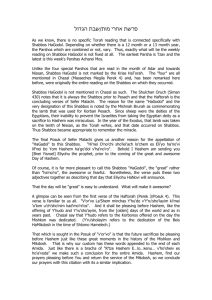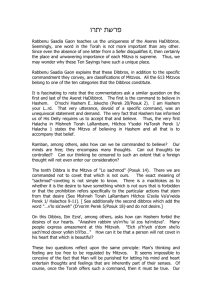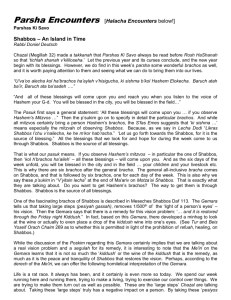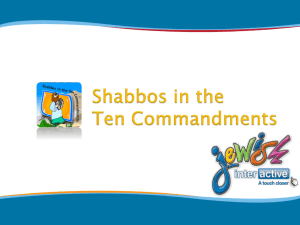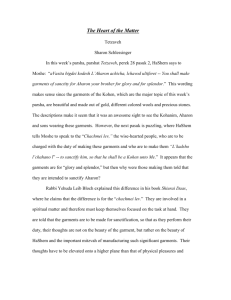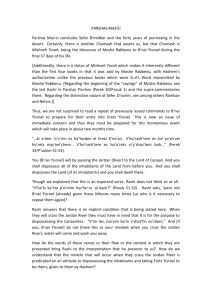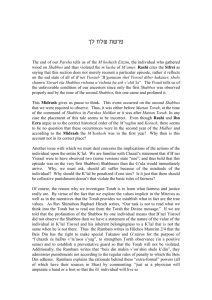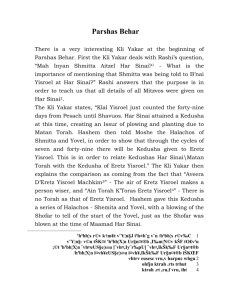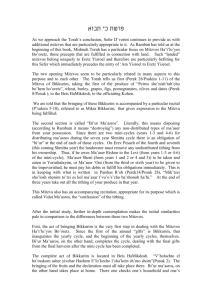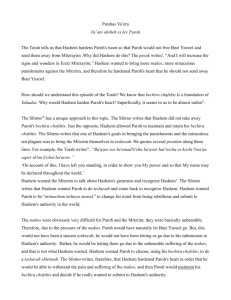פרשת פינחס
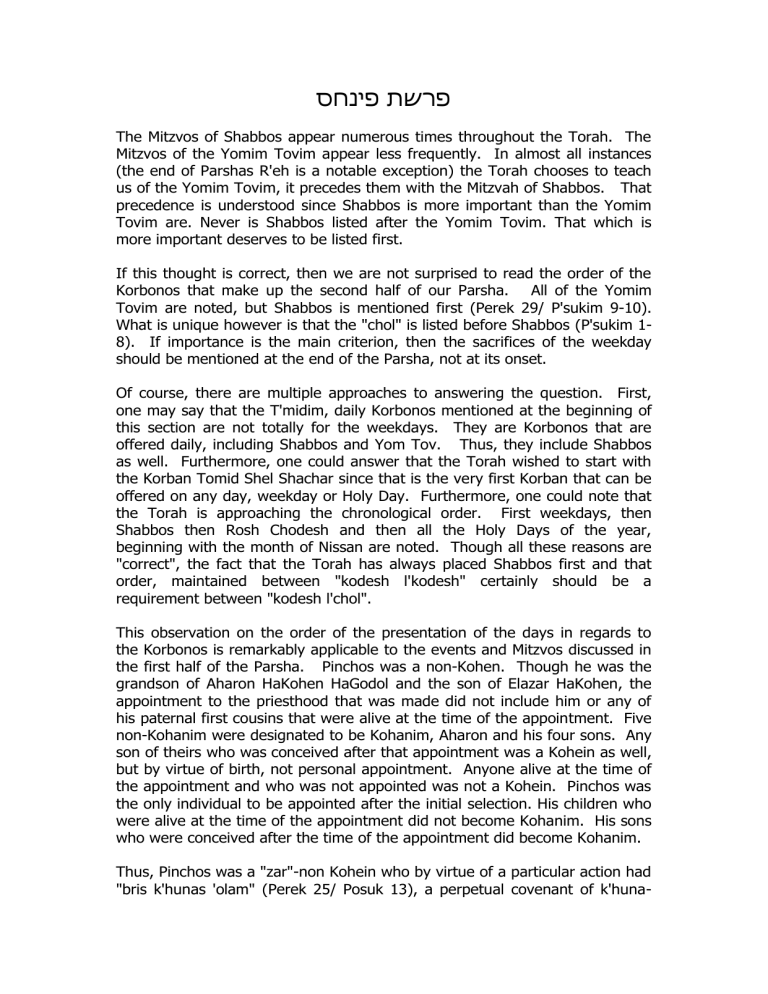
סחניפ תשרפ
The Mitzvos of Shabbos appear numerous times throughout the Torah. The
Mitzvos of the Yomim Tovim appear less frequently. In almost all instances
(the end of Parshas R'eh is a notable exception) the Torah chooses to teach us of the Yomim Tovim, it precedes them with the Mitzvah of Shabbos. That precedence is understood since Shabbos is more important than the Yomim
Tovim are. Never is Shabbos listed after the Yomim Tovim. That which is more important deserves to be listed first.
If this thought is correct, then we are not surprised to read the order of the
Korbonos that make up the second half of our Parsha. All of the Yomim
Tovim are noted, but Shabbos is mentioned first (Perek 29/ P'sukim 9-10).
What is unique however is that the "chol" is listed before Shabbos (P'sukim 1-
8). If importance is the main criterion, then the sacrifices of the weekday should be mentioned at the end of the Parsha, not at its onset.
Of course, there are multiple approaches to answering the question. First, one may say that the T'midim, daily Korbonos mentioned at the beginning of this section are not totally for the weekdays. They are Korbonos that are offered daily, including Shabbos and Yom Tov. Thus, they include Shabbos as well. Furthermore, one could answer that the Torah wished to start with the Korban Tomid Shel Shachar since that is the very first Korban that can be offered on any day, weekday or Holy Day. Furthermore, one could note that the Torah is approaching the chronological order. First weekdays, then
Shabbos then Rosh Chodesh and then all the Holy Days of the year, beginning with the month of Nissan are noted. Though all these reasons are
"correct", the fact that the Torah has always placed Shabbos first and that order, maintained between "kodesh l'kodesh" certainly should be a requirement between "kodesh l'chol".
This observation on the order of the presentation of the days in regards to the Korbonos is remarkably applicable to the events and Mitzvos discussed in the first half of the Parsha. Pinchos was a non-Kohen. Though he was the grandson of Aharon HaKohen HaGodol and the son of Elazar HaKohen, the appointment to the priesthood that was made did not include him or any of his paternal first cousins that were alive at the time of the appointment. Five non-Kohanim were designated to be Kohanim, Aharon and his four sons. Any son of theirs who was conceived after that appointment was a Kohein as well, but by virtue of birth, not personal appointment. Anyone alive at the time of the appointment and who was not appointed was not a Kohein. Pinchos was the only individual to be appointed after the initial selection. His children who were alive at the time of the appointment did not become Kohanim. His sons who were conceived after the time of the appointment did become Kohanim.
Thus, Pinchos was a "zar"-non Kohein who by virtue of a particular action had
"bris k'hunas 'olam" (Perek 25/ Posuk 13), a perpetual covenant of k'huna-
priesthood bestowed upon him. Thus, the extraordinary action that bound
Pinchos with HaKodosh Boruch Hu, "b'ri'si shalom" (Posuk 12), My [Hashem's] covenant of peace, came from Pinchos' initiative. The "chol" led to the
K'dusha.
Later in the Parsha, we find a quite similar event. The laws of inheritance that are far more than a property receivership code, are given to us by virtue of B'nos Tzloph'chod. These women were noteworthy for their piety and wisdom, however, they had no particular appointment. Certainly there were many other pious and wise women among B'nei Yisroel. In the previous generation it was due to "noshim tzi'ko'ni'yos", righteous women that they were delivered from Egypt. Thus, these laws that are one of the guarantors of the continuity of 'Am Yisroel from generation to generation have their inception in the initiative of B'nos Tzlophchod. In these cases, too, the start is one of "chol" that leads to the sanctity of Hashem's Mitzvos.
If the idea of the non-holy being able to direct to the holy is found multiple times in our Parsha and may be a principle that guides most of its content, the Haftorah for this week suggests a different idea.
In the middle of the three-week period known as "Bein Ha'm'tzorim" (a term borrowed from Eicha Perek 1/Posuk 3), between the straits, we recite weekly
Haftoros that reflect this tragic period in our history. The first of these
Haftoros is listed in the Chumash "officially" as the Haftorah of Parshas
Mattos, since in the few years when Mattos and Mas'ei are separated, Parshas
Pinchos occurs prior to the Three Weeks. But, as any perusal of our annual calendars will reveal, almost always Pinchos is the first Shabbos of the Three
Weeks and it "borrows" the Haftorah of Mattos (next week, the Haftorah of
Mas'ei will be read).
Taken from the first Perek of the Book of Yir'mi'yo'hu we are warned of the impending doom about to overtake our People at the end of the era of the first Beis HaMikdosh. "Mi'tzo'phon ti'po'sach ho'ro'oh" (Posuk 14) is the prophesy Yirmiyohu receives. The evil will come from the North. "Ki sho'kad a'ni" (Posuk 12). I, Hashem, am acting expeditiously (to bring the punishment upon B'nei Yisroel).
Who was the Prophet Yirmiyohu? The Novi reveals the answer to us.
"B'terem e'tzor'cho ba'beten y'da'ti'cho u'v'terem te'tzei mei'rechem hik'dash'ticho" (Posuk 5). Yirmiyohu was set aside in closeness to Hashem
("y'da'ti'cho") and holiness ("hid'kash'ticho"). It was on this basis that he was sent to the people to warn them of the destruction that awaited them and to remind them that such destruction did not have to become their fate.
Yirmiyohu started from the place of holiness. In his case, the Torah did not
"wait" for the initiative of the non-holy to make its mark. Hashem made sure that the holiness was ready and able to act. Thus, Yirmiyohu and his history are quite different from the Parsha with which they are associated.
In fact, there are two ways that describe the interaction between the
Heavenly and the earthly. One is referred to as "is'a'ruso d'l'sato" - arousal from below. The other is known as "is'a'ru'so d'l'ei'loh" - arousal from above.
When the initiative comes from Man it is called "d'l'tato" - from below. When the initiative comes from Hashem it is called "d'l'ei'loh" - from above.
It is fascinating to apply these ideas to the Parsha and to the Haftorah. In the Midbar, in the presence of the Mishkan and the Aron HaKodesh, there was a tremendous advantage. Even the "non-holy" was exposed in an extraordinary measure to the Holy. No one could ignore the Holy that was present all of the time. With such an environment there was room for the non-holy to seek holiness, to take initiative and to have the proper motivation. That is Pinchos and that is B'nos Tzlophchod. That explains the order of the Korbonos in our case, as well, telling the "common person", "you can accomplish and succeed. You can reach the heights of a Pinchos or that of the daughters of Tzlophchod.
In the time of destruction and disaster, as in the last years of the Bayis
Rishon, Hashem saw there was no natural expectation for "is'a'ruso d'l'sato" and thus He sent this unique Novi to provide the opportunity for "is'a'ru'so d'l'ei'loh".
We see that even when our opportunities are limited, Hashem will make sure that the occasion for Redemption is possible. That is the message of comfort we receive in the midst of recalling the disaster about which this period reminds us.
We must not ignore our Parsha, however, and its very clear message.
"Is'a'ruso d'l'sato" possesses extraordinary power. Pinchos saved 'Am Yisroel from lack of response of Moshe and Aharon (Perek 25/ Posuk 6) and from the plague that threatened all of them (Posuk 8). The order of the Korbonos gives that same message. We begin with "is'a'ruso d'l'sato", the weekday sacrifices and we end with the special one-animal sacrifice of Sh'mini Atzeres.
That day, the epitome of our Parsha, is marked by Hashem's calling of an
A'tzeres, a special convocation. He, Yisborach, turns to B'nei Yisroel, in response to their "is'a'ruso d'l'sato" and says, "koshoh 'o'lai prei'das'cheim,
'ik'vu 'od yom echod" (Rashi, Perek 29/ Posuk 36). Your separation is difficult for Me, stay an extra day.
While we await and pray for "is'a'ru'so d'l'ei'loh" we must not be inactive. We must seek the sanctity and salvation of HaKodosh Boruch. We must initiate it with the "is'a'ruso d'l'sato" that can bring the words of endearment that
Hashem utters, "koshoh 'o'lai prei'das'cheim" as we pray He will restore our closeness to Him and turn the days of mourning into days of happiness and joy.
Bvirchas Nechemas Tziyon
Shabbat Shalom
Rabbi Pollock
